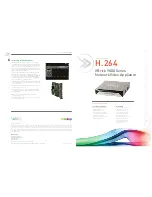
SERVICING
31
EXAMPLE
:
a. Suction Pressure = 143 psi
b. Corresponding Temp. = 50°F.
c. Thermometer on Suction Line = 58°F.
To obtain the degrees temperature of superheat, subtract
50.0 from 58.0°F.
The difference is 8° Superheat. The 8° Superheat would fall
in the ± range of allowable superheat.
NOTE
: The electronic expansion valve will maintain super-
heat automatically.
S-109 CHECKING SUBCOOLING
Refrigerant liquid is considered subcooled when its tem-
perature is lower than the saturation temperature corre-
sponding to its pressure. The degree of subcooling equals
the degrees of temperature decrease below the saturation
temperature at the existing pressure.
1. Attach an accurate thermometer or preferably a ther-
mocouple type temperature tester to the liquid line as it
leaves the condensing unit.
2. Install a high side pressure gauge on the high side (liq-
uid) service valve at the front of the unit.
3. Record the gauge pressure and the temperature of the
line.
4.
Review the technical information manual or specifica
-
tion sheet for the model being serviced to obtain the de-
sign subcooling.
5. Compare the hi-pressure reading to the "Required Liq-
uid Line Temperature" chart. Find the hi-pressure value
on the left column. Follow that line right to the column
under the design subcooling value. Where the two inter-
sect is the required liquid line temperature. Alternately
you can convert the liquid line pressure gauge reading
to temperature by finding the gauge reading in the R-
410A Pressure vs. Temperature Chart; find the tempera
-
ture in the °F. Column.
6.
The difference between the thermometer reading and
pressure to temperature conversion is the amount of
subcooling.
ADD CHARGE TO RAISE SUBCOOLING. RECOVER
CHARGE TO LOWER SUBCOOLING.
Subcooling Formula = Sat. Liquid Temp. - Liquid Line Temp.
NOTE
: To adjust subcooling, follow the sequence of :
EXAMPLE:
a. Liquid Line Pressure = 417 PSIG
b. Corresponding Temp. = 120°F.
c. Thermometer on Liquid line = 109°F.
To obtain the amount of subcooling subtract 109°F from
120°F.
The difference is 11° subcooling. See the specification sheet
or technical information manual for the design subcooling
range for your unit.
There are other causes for high head pressure which may
be found in the "Cooling/Heating Analysis Chart."
If other causes check out normal, an overcharge or a system
containing non-condensables would be indicated.
If this system is observed:
1. Start the system.
2. Remove and capture small quantities of gas from the
suction line dill valve until the head pressure is reduced
to normal.
3. Observe the system while running a cooling perfor-
mance test. If a shortage of refrigerant is indicated, then
the system contains non-condensables.
Charging Table
OD Ambient Temp
(degF)
<65°F
65°F to 105°F
>105°F
Subcooling
(degF)
Wheigh in
Charge
8°F ± 1°F
Weigh in
Charge
SUPERHEAT AND SUBCOOLING ADJUSTMENT ON
TXV APPLICATIONS
NOTE
: Subcooling and superheat information is valid only
while the unit is operating at 100% capacity or 100% com-
pressor speed in CHARGE MODE.
Compressor speed is displayed under STATUS menu in the
thermostat.
1. Run system at least 10 minutes to allow pressure to
stabilize. During the adjustment of subcooling, ambient
temperature should be greater than 65°F and less than
105°F. If ambient temperature is out of range, don’t ad-
just subcooling.
2. For best results, temporarily install a thermometer on
the liquid line at the liquid line service valve and 4-6"
from the compressor on the suction line. Ensure the
thermometer makes adequate contact and is insulated
for best possible readings. Use liquid line temperature
to determine subcooling and vapor temperature to de-
termine superheat.
NOTE
: AN OPTIONAL METHOD IS TO LOCATE THE
THERMOMETER AT THE SUCTION LINE SERVICE
VALVE. ENSURE THE THERMOMETER MAKES AD-
EQUATE CONTACT AND IS INSULATED FOR BEST
POSSIBLE READINGS.
3. The system subcooling should be 8°F ± 1°F. If not in that
range, adjust subcooling and superheat according to the
following procedure.
a. If subcooling and superheat are low, adjust TXV to 7
to 9°F superheat, then check subcooling. NOTE: To
adjust superheat, turn the valve stem clockwise to
increase and counter clockwise to decrease.
















































